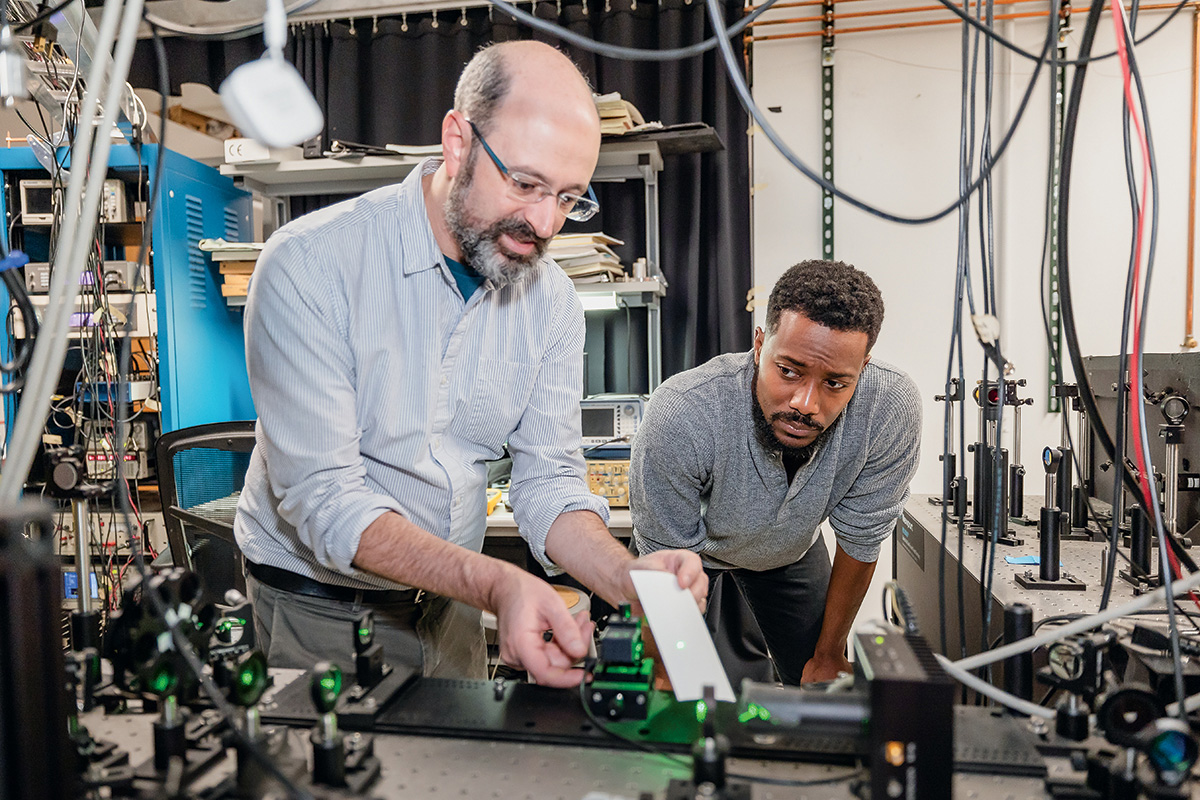lens
Uncommon Sensors
Using quantum sensing to probe magnetic materials
 PHOTO: Matt ShifflerAssociate Professor Jesse Berezovsky, left, and PhD candidate Jonathan Miller adjust a laser used in their research to harness a quantum state called superposition
PHOTO: Matt ShifflerAssociate Professor Jesse Berezovsky, left, and PhD candidate Jonathan Miller adjust a laser used in their research to harness a quantum state called superpositionThe ruler in your junk drawer, the clock on your kitchen wall, the scale in your bathroom: Humble as they seem, they are all participants in the grand human endeavor of measurement. For thousands of years, we have measured our world and, by measuring it, have come to better understand it.
Now, Case Western Reserve's Jesse Berezovsky, PhD, is building a device that he said can "measure something no one has ever measured before:" the extremely low-level magnetic fields inside cutting-edge materials essential for producing green technologies like electric motors and smart grids.
Berezovsky, an associate professor of physics, is leading a multidisciplinary team from CWRU and the University of Florida, which was recently awarded $1 million from the National Science Foundation's Quantum Sensing Challenges for Transformational Advances in Quantum Systems program.
Quantum sensing capitalizes on the logic-twisting laws of quantum physics to measure the world in ways that were previously impossible. Berezovsky aims to harness a quantum state called superposition, which allows a particle to "spin" in two apparently contradictory directions at once. (Spin is physicists' short-hand for the magnetic properties of subatomic particles.)
"This state is fragile and susceptible to being scrambled by the environment," Berezovsky said. Quantum sensors can exploit this fragility to detect tiny changes in magnetic fields.
Identifying such changes could help Berezovsky and Matthew Willard, PhD, a CWRU professor of materials science and engineering, with research that might ultimately lead to options for better electricity transmission.
"It might allow you to improve the materials in a more directed way," leading to even more efficient electricity transmission, he said. Their research is complemented by the work of Assistant Professor Shulei Zhang, PhD, who specializes in theoretical physics problems.
Berezovsky's magnetic sensing device is made from diamond nanocrystals, bits of diamond so minute that only a virus could wear them as jewelry. Pure diamond is made up of carbon atoms locked together in a perfectly regular crystalline lattice. The diamond in Berezovsky's lab, though, is sprinkled with nitrogen. When a nitrogen atom bumps a carbon atom out of the crystal, it can take that carbon atom's place in the lattice and then join with an empty spot that is missing another carbon atom, creating a particular kind of defect. That defect leaves behind "extra" electrons, which are highly sensitive to a magnetic field—even a weak one—and that field nudges their energy very slightly. Detectors built into the sensor can translate that energy shift into a magnetic field strength.
Because they are so small—just two atoms lodged inside the diamond nanocrystal—the sensors can be brought snug against the magnetic source being measured. That amplifies their sensitivity and allows them to pick out tiny details, all the way down to the spin on a single electron or proton.
Berezovsky relishes building experiments that cross quantum weirdness with practical materials science. "We have to grapple with these questions about how the macroscopic world is quantum," he said. "That is really exciting to me."
— KATE BECKER





